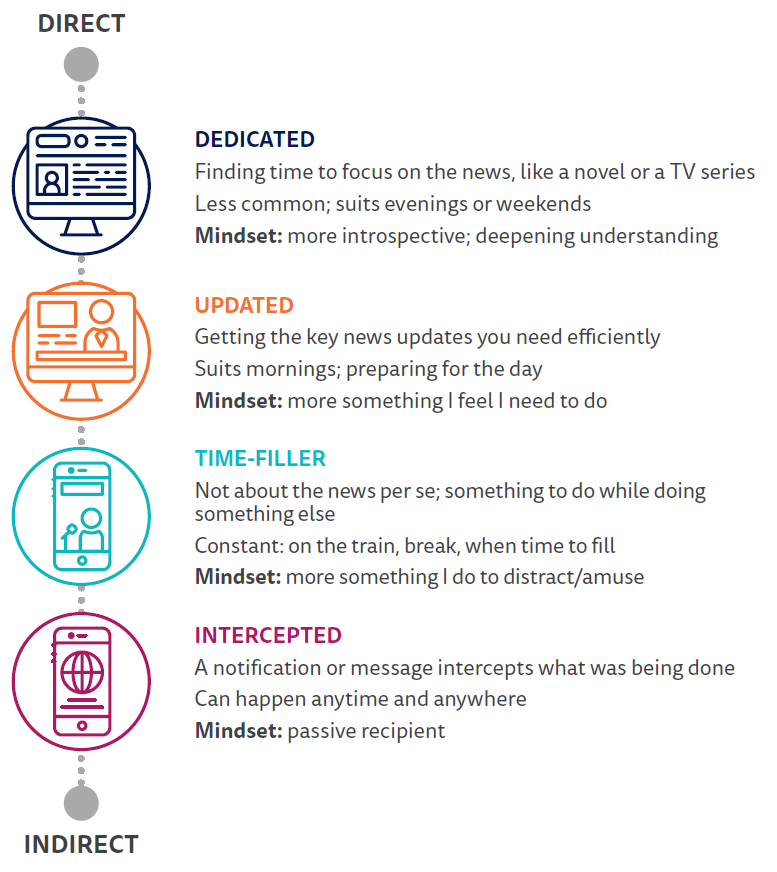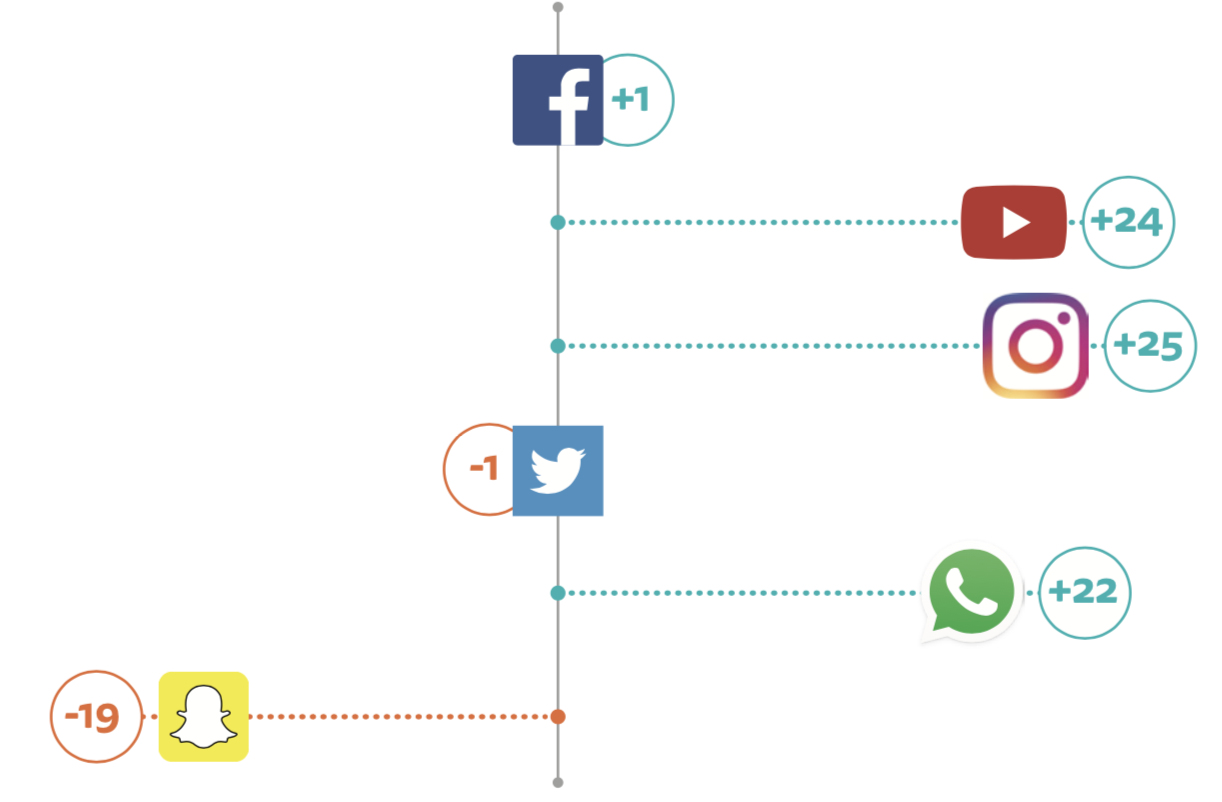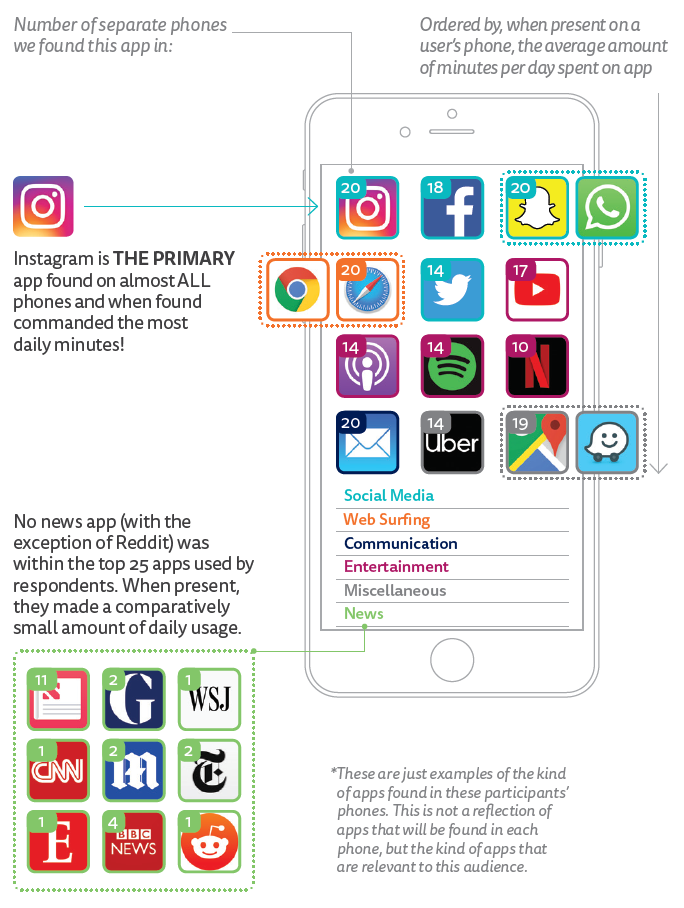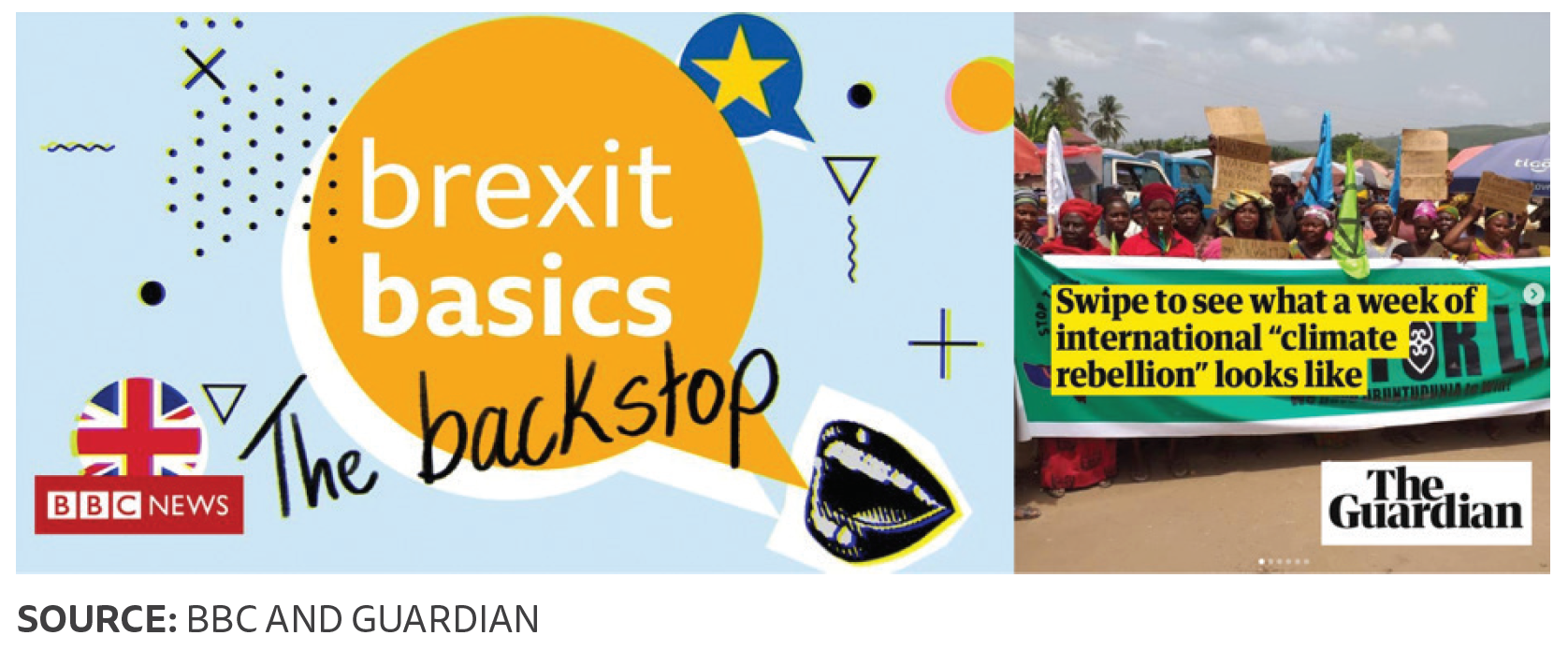In this section we look at the news consumption of younger generations – a group that is of great interest to news publishers around the world, but also one they are finding it increasingly hard to reach. We explore the attitudes and behaviours that define the under 35s, and ask what kind of journalism or brand positioning might appeal to them. Our data highlight that young people are very reliant on mobile, and spend a lot of time with a range of different social networks. As such, much of their media use is on-demand and algorithmically curated/personalised. The problem for publishers is that this means that individual news brands tend to play a small role in young people’s lives.
Here, we make a distinction between Generation Y (Gen Y) – often called millennials and represented in our sample by those aged 25–34 – and Generation Z (Gen Z), those born after the mid-1990s and aged 18–24.1 The reason for this separation is that Gen Z are often thought of as digital natives with no memories of the pre-internet age. Gen Y, on the other hand, grew up at the turn of the millennium in a world without Facebook and YouTube.
Throughout this section we will combine our survey data with detailed qualitative data collected from young people in the UK and the US. This study, conducted by market research agency Flamingo, was based on tracking the news behaviour of a strategic sample of 20 participants over two weeks in January/February 2019, followed by in-depth interviews with them and their friends. The sample was made up of young people with different news habits, from a range of socio-economic backgrounds.
Primacy of the Smartphone
Data from both the survey and the qualitative research emphasise what we have known for some time – that young people are highly reliant on their phones. Our digital tracking in the US and UK shows that Gen Z and Gen Y spend a large part of their waking hours interacting with smartphones. They use them for communication, for media, for games, for dating – and for news. Across all markets, our survey data reveal that the smartphone is the main device used for accessing news for the vast majority of under 35s (69%).
Another way of illustrating the primacy of smartphone news for young people is to look at data on their first contact with news on a typical day.2 Nearly half of Gen Z news users (45%) in our combined sample come into first contact with news in the morning via the smartphone, with only 19% via TV and 5% via desktops/laptops. Similar trends can be seen among Gen Y, who also first turn to their smartphone (39%) over TV (22%) or the computer (8%). By sharp contrast, for over 35s television is still the most likely first contact point with news (30%), with smartphone (19%) and radio (18%) some way behind.
We can also look in more depth at where people go when they first pick up their smartphones for news. While those over 35 are likely to first go directly to a news site via an app or the mobile browser (39%), Gen Z are more likely to turn to social media and messaging apps (57%). In other words, news brands are less important for this group than for over 35s. Gen Y are somewhere in the middle, with 43% getting their news via social media and messaging apps and 33% directly. Facebook is equally popular as a first destination with both groups, and Instagram has become more popular in the last few years as a first destination. Interestingly, Twitter is twice as popular with Gen Z users compared to Gen Y users. Direct traffic is relatively more important in the UK than in the US, partly due to the prominence of publishers like BBC and the Guardian.
Insights from the in-depth interviews in the UK and the US reveal similar patterns among young people:
The first thing I would do would be check social media, see if there’s anything on Facebook.
Courtney, Gen Z, US
In the morning, I’ll go to the BBC app. I will literally click on it, and I will go, ‘Right, okay, what’s happening?’
Chloe, Gen Y, UK
Moments of Consumption
Our qualitative research, which relied on tracking data and interviews with a group of 20 participants, identified four key moments of news consumption for young people: (i) dedicated moments where they give time to news (usually on evenings and weekends), (ii) a moment of update (usually in the mornings), (iii) time fillers (commuting or in a queue), and (iv) intercepted moments where they receive alerts from news organisations or messages from friends with news. Of course, not all young people use all four moments, but most did use some combination of these.
FOUR TYPICAL KEY NEWS MOMENTS FOR YOUNGER GROUPS
Social media, as one example, are important for keeping young people updated and for filling time, but are not an appropriate place for dedicated news consumption:
It’s kind of like being somewhere and seeing something in a far-off distance and being like ‘oh, what’s going on over there?’ and you go and see it on Twitter and then you let them take you somewhere …
Alex, 31–35, UK
Young news users also rely on news aggregators like Apple News, Flipboard, and Upday, particularly when they use news in ‘time filler’ moments or want to get a quick update about what is happening during intercepted moments (e.g. via a news alert). Aggregators are increasingly prominent on smartphones, where headline lists can be accessed by swiping left or right from the smartphone homescreen on many handsets. According to the interview findings, aggregators have two distinct audiences. Among engaged young users they are used to curate the news they want and exploit the diversity of sources. For more passive news users, using an aggregator is an easy way to browse around series of headlines.
If I’m somewhere where I don’t really have time to read a news story, I do rely on headlines. The fact that I have access so that I can look at in two seconds, because I’m not really supposed to be on my phone at work but if I can just pull it out, click one button to get to the Apple News story and the answer is right there for me.
Maggie, Gen Z, US
For Gen Z, and to a lesser extent Gen Y, the key appeal of these services is convenience. Both groups enjoy multitasking, and they want media to fit the device and networks where they spend their time.
Young People are Changing their Preferences around Social Media
Looking in more depth at the role of social media networks, we find significant differences between the groups, and also changes over time. Facebook is used slightly more by Gen Y (52%), while Twitter, Instagram, and Snapchat are used significantly more by Gen Z news users than millennials or by users over 35.
[Facebook is] ancient. Like, a mum’s thing. I don’t really use it anymore.
Ellie, Gen Z, UK
We can also consider the amount of time that people spend on these platforms, and how it’s changing.
Our survey data suggest that most young people (and in particular those in Gen Z), spent a lot more time on Instagram this year compared to last. On the other hand, there was a decrease in time spent with Snapchat – something that might worry publishers who have invested heavily in the Discover news platform.
NET DIFFERENCE IN TIME SPENT WITH EACH SOCIAL NETWORK IN LAST YEAR BY UNDER 35S
All markets
Base: Under 35s that used each social network in the last week: Facebook = 15,267, YouTube = 15,838, WhatsApp = 11,448, Instagram = 11,725, Snapchat = 4674, Twitter = 5249. Note: Showing difference between proportion that said ‘more time’ and proportion who said ‘less time’.
However, while many publishers think of Instagram as ‘the platform’ to reach younger groups, young people themselves often do not see it as the right environment for news:
I don’t think I would follow them [news organisations] on Instagram. … When I go on Instagram my mindset is ‘I’m going to get information but it’s more related to entertainment.’
Richard, Gen Y, UK
Once again, understanding the expectations of different audiences and the ‘moments’ they are in will be critical for engagement with particular platforms.
Identifying with News Brands
What is the role of traditional news brands in this distributed ecology? Insights from our digital tracking of news users’ mobile consumption reiterate that news brands play a very small role in young people’s lives. Most smartphone time was taken up by social network apps, internet browsers, podcasts, mail, and movie/music streaming devices – followed by dating apps, maps, and transport applications. Young people have a very low threshold for apps that don’t provide a great experience, while they value services that are relevant and useful at all times. No news app was within the top 25 apps used by all the respondents in the study, whereas Instagram was the application found on almost all phones with the highest use in terms of daily minutes used.
HOW YOUNG PEOPLE SPEND TIME ON THEIR SMARTPHONES AND ROLE OF NEWS
Aggregated view across 20 respondents
This does not mean that traditional brands are not valued by young consumers. Most do have an ‘anchor news brand’ that they will turn to when a major story breaks and needs verifying – in our qualitative research study this was typically the BBC or Guardian in the UK, and CNN or the New York Times in the US. The choice of this brand is often heavily influenced by early parental influence but the format is almost always digital.
Tone, Agenda, and Formats
In our interviews, young people were often frustrated by the negativity of the news agenda, about sensationalism and about perceived agenda of the mainstream media. Sometimes they feel that the views and concerns of their generation – such as climate change and minority rights – are not properly represented. But equally they do not want traditional media to go away, dumb down, or radically change their style just to appeal to them. For instance, young people expressed dissatisfaction with the tone used by automated news bots built by traditional news brands:
– I don’t need the news to be my friend.
– No. (×2)
– It doesn’t need to tell me ‘Hey, you know what’s happening in India right now?’ It can just be like, ‘Hey, this is what’s happening in India.’
– Yes, exactly.
Chloe, Victoria, Monica, Gen Y friendship group interview, UK
On the other hand, they also expressed strong interest in news formats that were more visual and easier to consume than an 800-word article. Some said the lack of context or background was often a problem too, so visual explainers – like those pioneered by Vox – tested well; as did other kinds of visual and mobile storytelling including graphical storytelling from publishers like the Guardian and the BBC.
VISUAL FORMATS ARE PROVING POPULAR WITH YOUNGER AUDIENCES
Podcasts were strikingly popular with our young respondents, but the appeal of online news video was more mixed. Younger groups are more likely to use online video than older generations, with around 15% of 18–24s saying they prefer using it to text. Again, we find that Instagram is playing a central role in popularising news video. However, it should be noted even among Gen Z, the majority (58%) prefers text over video because of the control and flexibility that text still offers. Video is not the way to engage young people, rather it is one of many formats that can engage.
Implications for Publishers
Overall, we find differences between Gen Z and Gen Y as well as significant overlaps. Both groups have fully embraced digital media – albeit in slightly different ways, with Gen Y carrying a certain nostalgia for the physicality of older forms of media, and Gen Z apparently having little time for media that does not display well on a smartphone or does not meet their exacting requirement for relevance forged by Facebook, Netflix, and Spotify. Both groups understand the importance of traditional news brands, but tend to be less loyal than their parents – preferring to pick-and-mix from multiple outlets.
The increased reliance on social media and other algorithmically driven services – which we have documented for several years – highlights that these generations do not want to work hard for their news. This year’s qualitative study shows that they want news access to be easy, and entertaining – but they also want it to be authentic, fair, and meaningful. They certainly don’t want it to be dumbed down.
None of this makes it easy for publishers to define strategies that will keep these groups happy at the same time as satisfying more traditional audiences with stronger allegiances and patterns. To some extent new formats like podcasts and explainers may help bridge the divide but it seems unlikely that younger users will ever be persuaded to pursue a monogamous relationship with the news or to abandon their platform-based habits. All this suggests that working to identify ways to reach and monetise audiences on third-party platforms will become an increasingly important focus for industry.
A full report on the findings of the qualitative study in the UK and US will be published in September 2019 (in conjunction with Flamingo Research).




